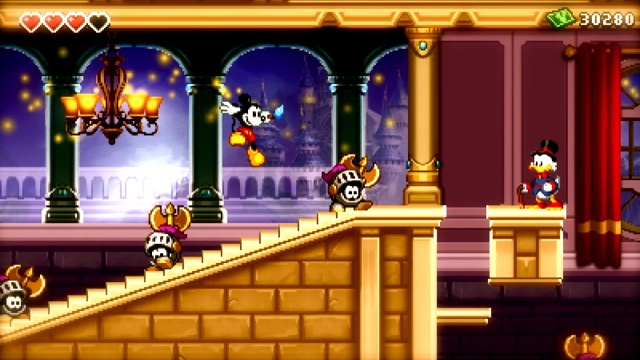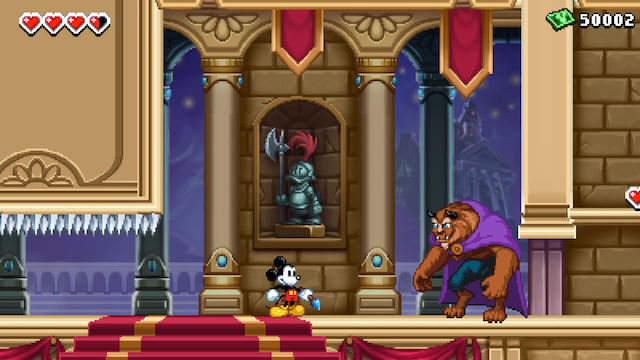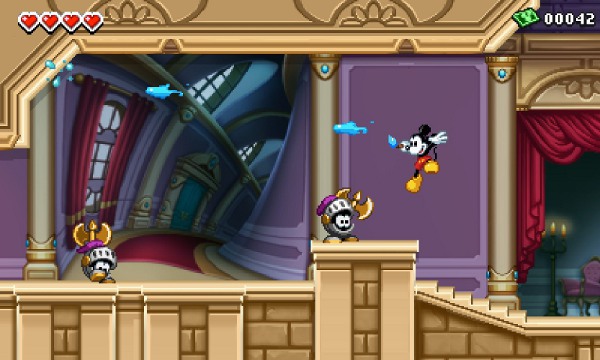

Developer DreamRift was arguably one of the best developers for Nintendo DS. The creators behind Harry Hatsworth in the Puzzling Adventure founded the studio and then whipped up the addictive Metroidvania/pet-sim combo, Monster Tale. Not only were these games stellar experiences, but they also took advantage of the DS’ two screens in creative and fun ways.
Now, DreamRift hopes to continue its success on Nintendo 3DS with one of the world’s most iconic figures– Mickey Mouse. Disney Epic Mickey: Power of Illusion is a spinoff portable game of the Epic Mickey franchise and will complement Disney Epic Mickey 2: Power of Two later this year. DreamRift co-founder and creative director Peter Ong talked with us via email about the game’s origin, its Castle of Illusion roots, dual-screen mechanics and stereoscopic-3D visuals.
Nintendojo: When and how did this project begin? Did Disney come to DreamRift about a portable version of Disney Epic Mickey or was this something you and your team pursued?
Peter Ong: After DreamRift finished working on the Nintendo DS game, Monster Tale, I sat down with our co-founder/technical director Ryan Pijai to consider what type of game we would most be interested in tackling next. One of the ideas that we came up with was a Nintendo 3DS concept where the user would be able to paint or draw objects on the bottom screen that become a part of your interactive environment. We were so excited with this idea that we soon began to talk to Disney Interactive Studios about it, as we already had a fantastic relationship with them.
It seemed that we were destined to work together some day. Things came together very quickly once we began discussing our next game ideas with them. Disney let us know that they were very interested in bringing Disney Epic Mickey onto the 3DS, and much to our delight, their priorities for the 3DS game were to make the highest-quality game possible, while also making it a unique experience that stands on its own rather than a port of the console version of the game. Upon hearing that, we immediately became very excited about the idea, being huge Disney fans, and having so much respect for the obvious passion with which Warren Spector and his team approached the first Disney Epic Mickey game. It was immediately apparent to us that our game mechanic was a fantastic fit for bringing Disney Epic Mickey to the 3DS. Being a huge Castle of Illusion Starring Mickey Mouse fan myself, I jumped at the chance very early on to tie it in with Disney Epic Mickey.

ND: What common threads and gameplay mechanics does Disney Epic Mickey: Power of Illusion share with its console counterparts? In what ways is the portable title straying from Warren Spector’s creations?
Peter: One of the things that impressed me immediately about Warren is his understanding that a game should be adapted based on the team and hardware platform, ideally maximizing the unique strengths involved. Although Disney Epic Mickey: Power of Illusion is a standalone experience, fans of Disney Epic Mickey will immediately recognize many core gameplay similarities with the 3DS game.
The first and most important mechanic inspired by the original Disney Epic Mickey console game is the central idea of having Mickey paint to create and remove objects within his interactive environment using paint and thinner. We hope that the audience not only finds the mechanic here to be familiar but is engaged in a manner in which we have adapted the idea to best suit the 3DS console. In addition, Mickey also has the ability to use paint and thinner and a spin attack in order to overcome challenges, as also seen in the console game.
One of the exciting new features for this 3DS game is that when Mickey paints an object, it now matters how well the player has painted the object in terms of how the object will come into play interactively once it’s a part of your environment. Additionally, the audience may notice moves that are similar to Castle of Illusion Starring Mickey Mouse such as Mickey’s ability to jump into the air and bounce off of enemies.
ND: Not much is known so far about Disney Epic Mickey: Power of Illusion, except that it’s a tribute to Castle of Illusion Starring Mickey Mouse. Exactly how is this new game a tribute — similar game mechanics, visuals, etc.?
Peter: The premise of Disney Epic Mickey: Power of Illusion is that the Castle of Illusion from the classic Sega Genesis game has appeared in Wasteland, where forgotten things go. Mickey’s adventure takes place within the Castle of Illusion which is situated within the universe of Disney Epic Mickey. The game mechanics and the visuals are grounded in both Disney Epic Mickey and the Castle of lllusion Starring Mickey Mouse.
In terms of its ties to Castle of Illusion Starring Mickey Mouse, users might notice many familiar sights and features from the original game. In Castle of Illusion Starring Mickey Mouse, we really loved the way that each level was a surreal illusion that brought together different imagery from beloved Disney masterpieces. Likewise with this game’s levels, we’re looking to draw from our favorite Disney works, to create environments that pay homage to Disney’s rich history. Although at first glance, the original Castle of Illusion Starring Mickey Mouse may seem to be a deceptively simple game, we have an enormous amount of respect for the amount of gameplay nuance that’s present in the game, and we’re really hoping to capture that ingenious dimensionality in Disney Epic Mickey: Power of Illusion as well. As a result, we’re taking inspiration from many things ranging from Mickey’s set of moves, to enemies and obstacle design, that we hope will express at least some part of the amazing ingenuity that went into the original game.
ND: Are there any other inspirations behind the game? DreamRift has paid homage to Metroidvania and Mega Man games in previous works.
Peter: Being big gamers ourselves, the reason why we make games, and why DreamRift was created in the first place, was to explore the love that each of us has developed growing up with our individual video game experiences. Consequently, every game that we make naturally involves drawing inspiration from the variety of games that we hold nearest and dearest to our hearts. With respect to the reference about the Metroidvania level structure in Monster Tale … this time around, we’re once again going for a level structure people may not expect from this particular game.
In Disney Epic Mickey: Power of Illusion, the levels within the game each take place within different parts of the Castle of Illusion, and thus they each draw upon different Disney works. However, in between levels, there is a safe area called the Fortress which not only connects all of the gameplay level areas together, but also functions as a sort of community where Toon characters rescued by Mickey within gameplay levels end up residing. In between levels, Mickey can visit the Fortress, where he can work together with these Toon characters to not only evolve the Fortress itself, but also to gain rewards from each character that in turn affect gameplay inside of levels.
ND: DreamRift is known for its clever use of the dual screens with previous titles like Monster Tale. How will Power of Illusion utilize both displays?
Peter: Thank you so much for the kind compliment! With Disney Epic Mickey: Power of Illusion we are once again attempting to utilize both of the screens on Nintendo’s handheld in a way that we haven’t really seen before. In a nutshell, the way that the central mechanic of the game works is that the player controls Mickey on the top screen, playing through an action-platforming environment, while at the same time on the bottom screen, the player is able to use the stylus and the touch screen to create or remove objects from that interactive environment on the top screen using paint and thinner. Not only does this allow the player to dynamically customize the environment within which Mickey plays, it also provides a system where the player is rewarded further for how well they paint an object on the bottom screen through improved versions of objects manifesting on the top screen when the player performs better. When combined with Mickey’s action platforming abilities, this central mechanic offers many types of gameplay challenges that haven’t existed before in a game.

ND: Your previous creations were original IPs for DS — Henry Hatsworth in the Puzzling Adventure and Monster Tale. Has it creatively been hard after that to come back and work within the confines of such an established and world-renowned character like Mickey?
Peter: With games like Hatsworth and Monster Tale, our core team members were able to demonstrate their passion for creating original universes from scratch combined with innovative gameplay. We always knew it would take something really special in order for us to tackle our first game within an existing universe.
Miraculously everything aligned more perfectly than we could have imagined with the opportunity to bring Disney Epic Mickey to the 3DS. As mentioned previously, we were already experimenting with a central gameplay mechanic that translated directly to how we would have brought Disney Epic Mickey to the 3DS in the first place, which made things much easier. We immediately realized that the mechanic we were experimenting with was also much stronger when married with the vast library of beloved Disney imagery universally loved all over the world, as people would feel more engaged in helping to create something that they already have an emotional connection with. These were all quite serendipitous circumstances that are difficult to replicate.
Additionally, the opportunity to work not only with Disney, but to draw from so much of Disney’s history is a gigantic privilege to every one of DreamRift’s team members. On top of that, I can’t imagine ever turning down the opportunity to work with Mickey Mouse nor with the Castle of Illusion. Any one of the many things I just mentioned would be enough for us to know that this is an unbelievable game to work on.
ND: Speaking of your previous creations, how has DreamRift matured and grown since making Monster Tale?
Peter: There are many things that I think a developer should continuously try to improve upon from one game to the next. We are always evaluating the fairness of difficulty in our games and how well or not the mechanics that we experimented with worked in a game. With each of our prior games, it was easier to objectively assess various facets of the game after having actually finished the games and being able to watch the audience play them. With those experiences under our belt, we approached this game with more knowledge of how to avoid difficulty spikes and level content that may provide unfair circumstances for the user. Additionally, with our prior games, we explored uniquely incorporating bottom screen mechanics with top-screen gameplay with varied results. Although the paint and thinner mechanics on the bottom screen in Disney Epic Mickey: Power of Illusion are a new idea, those prior experiences in creating innovative dual-screen mechanics have equipped us to implement that central core mechanic while avoiding potential pitfalls we’ve encountered before.
ND: This is DreamRift’s first game for 3DS. Along with the dual screens, how is the company taking advantage of the system’s other unique attributes — 3D, SpotPass, StreetPass, etc.?
Peter: We are so excited by the multitude of amazing features on the 3DS, and we have a lot of ideas we can’t wait to bring to fruition. For example, we have been particularly excited about the stereoscopic-3D display capability of the 3DS from the start. When we first heard of the stereoscopic-3D capability of the system, we asked ourselves what the most dramatic way to portray and utilize that feature would be. The first thing we anticipated was that the majority of games would be made with polygonal 3D graphics and that were simply flipped on to display stereoscopically.
Expecting that to be a common norm experience on the 3DS, we asked ourselves what kind of game would stand out with respect to employing stereoscopic 3D. Counter-intuitively, we realized that it might be most dramatic for the game to display objects in such a manner that the audience did not always see them in stereoscopic 3D and instead we wanted to provide key moments where objects would be seen crossing the bottom screen in non-stereoscopic 2D, then transitioning dramatically into stereoscopic 3D as they became painted into the top screen. We felt that this kind of real time punctuated display of stereoscopic 3D would be a really striking way to show off the feature in the 3DS. Additionally, we’ve noticed that when people see objects in stereoscopic 3D within a game that they expect to sort of emulate real world 3D — such as games with polygon-based 3D graphics — the stereoscopic 3D feature seems to be taken for granted and goes unnoticed. However with a 2D sprite-based game, the stereo 3D effect becomes a whole new experience. Because we may not expect to see these more illustrative non-literal 2D visuals projected in a stereo 3D manner, the sight of it really draws the eye.
Disney Epic Mickey: Power of Illusion hits store shelves later this year.




 ShareThis
ShareThis






